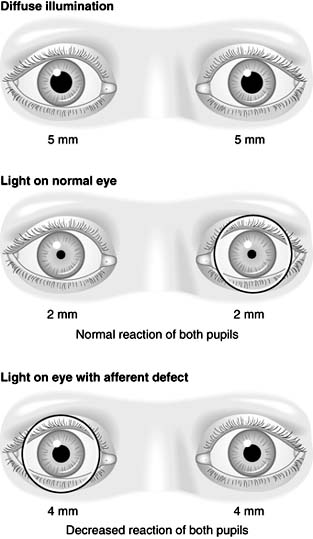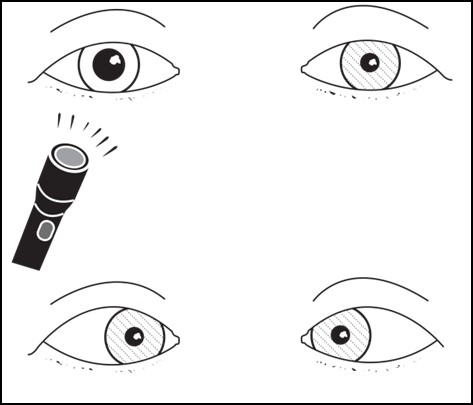

Definition: dilation of the pupil ( > 4 mm in daylight).

Pupillary control is mediated by both parasympatheticand sympatheticinnervation.

Occurs via the medial recti muscles bilaterally and is mediated by the oculomotor nerve ( CN III).Simultaneous inward movement of both eyes to maintain focus on close objects (e.g., eyes crossing when looking at one's own nose).Constricted ciliary muscle → relaxed ciliary processes → curvature of lens increases.Relaxed ciliary muscle → tense ciliary processes → curvature of lens decreases.Changes occur via contraction of ciliary muscles and are mediated by the Edinger-Westphal nuclei bilaterally.Primarily mediated by the lens, which changes convexity to adapt the refractory power.Accommodation: adjustment of the eyes to different distances (near vision versus far vision).impairment of the pupillary reflex) → pupils are anisocoric Isolated unilateral efferent pupillary defect (i.e.Sympathetic nervous system mediates motor innervation of the iris dilatator muscle.Parasympathetic nervous system mediates motor innervation of the iris sphincter muscle.Efferent neural pathway (efferent limb): impulse transmission to the iris sphincter muscle.Illumination of the unaffected eye leads to normal pupillary constriction in both eyes.Illumination of the affected eye leads to reduced/absent constriction of both pupils.Isolated unilateral afferent pupillary defect(e.g.
#ARGYLL ROBERTSON PUPIL LIGHT NEAR DISSOCIATION REGISTRATION#
Registration of light stimulus in the eye and transmission of the impulse to the central nervous system.Afferent neural pathway (afferent limb).Fixed pupil: the absence of pupillary response to a light stimulus or convergence testing.Isocoria: the pupils of both eyes are the same size.


 0 kommentar(er)
0 kommentar(er)
